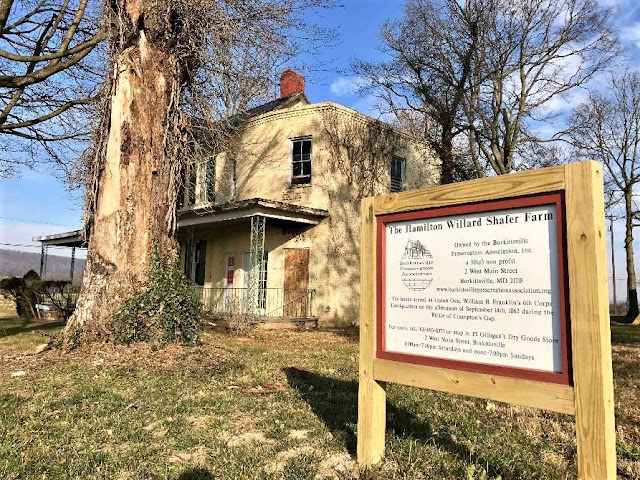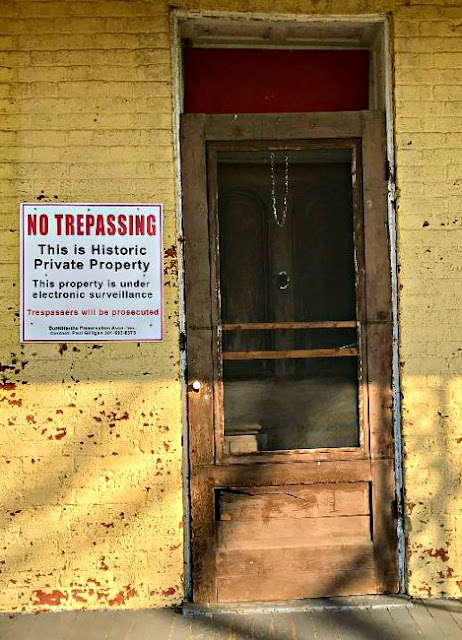 |
| The circa-1820 Shafer house was Union General William B. Franklin's headquarters during the Battle of Crampton's Gap on Sept. 14, 1862. (CLICK ON ALL IMAGES TO ENLARGE.) |
 |
| The Burkittsville Preservation Association aims to restore the historic property. |
From the outside, the old brick house near Burkittsville, Md., looks like it belonged in The Blair Witch Project, the 1999 horror film set in the hamlet at the foot of South Mountain.
More than 155 years ago, this circa-1820 house at the corner of Gapland and Catholic Church roads was the setting for momentous events. In September 1862, thousands of soldiers in the Union Army's VI Corps camped in the fields surrounding Martin Shafer's house, about a mile east of Burkittsville. As cannon boomed nearby, Union General William B. Franklin established his headquarters on the property on the afternoon of Sept. 14. The 39-year-old corps commander, a career soldier and expert engineer, apparently made himself at home, enjoying a meal and smoking cigars in the yard with fellow generals Baldy Smith, Winfield Scott Hancock and Henry Slocum, among other VI Corps brass.
 |
| From a broken window inside the house, a view of South Mountain, where the armies clashed on Sept. 14, 1862. The hamlet of Burkittsville, Md., is a mile down the road. |
After years of neglect, the property was donated in September 2016 by a relative of its last owner to the Burkittsville Preservation Association, which aims to restore it and make it a tourist attraction in the Civil War-rich area. The BPA, led by Paul Gilligan, faces significant challenges, not the least of which are financial. In addition to suffering from old age, the house has been abused by squatters and other trespassers. The outbuildings -- a Pennsylvania-style bank barn, meat house and a well house -- also need significant repairs. Total cost to save the property could perhaps top $1 million. (If you wish to donate money to help save the property, go to the donation section of the BPA site.) Preservation Maryland is also involved in the effort to save the Shafer farm.
While the stunningly beautiful area surrounding the Shafer farm looks much as it did in 1862, the farmhouse is much changed since the Civil War. Volunteers have made significant outside repairs and removed heaps of trash and other debris from inside the once-stately home, a veritable time capsule. Among the items discovered inside was a late-19th century William Jennings Bryan political pin.
 |
| A bottle of DDT, the long-banned insecticide, on a shelf. |
On my impromptu tour with BPA board member Todd Remaley, I examined curiosities. Covered with dust, an old brown bottle of DDT, the long-banned insecticide, stands on a dusty shelf. In the attic, beams are numbered with Roman numerals, a common construction practice long ago. In a downstairs room, perhaps the very one where Franklin met with Union commanders in 1862, four old ironing boards rest against a wall. Were they used by the most recent owner, who may have used the house as a laundry during the Depression?
Of course, many other questions remain: What would an archaeological study of the property reveal? Where are accounts of soldiers who briefly made the Shafer property home in the fall of 1862? What other secrets does the house, last lived in in 2000, hold?
But the greatest question is this one: Can this historic property really be saved for future generations?
 |
| The well house (left) and meat house in the backyard. |
 |
| The meat house must be stabilized. |
 |
| The foundation and walls of the house need significant repairs. |
 |
| Front entrance to the Shafer farmhouse. |
 |
| A downstairs room shows the ravages of time. |
 |
| An apparent target of a thief, the fireplace mantle is loosened from its moorings. |
 An old mirror in a downstairs room reflects recent visitors. |
 |
| Roman numerals carved into ancient attic beams. |

Thanks for posting this information, John!
ReplyDeleteKeith Murray, BPA Board Member and Webmaster
You bet, Keith. Best of luck on your project to save history.
ReplyDeleteKeep up the excellent work brother!
ReplyDeleteKeeping history alive...
DeleteI stopped in front of this house with my two friends last summer as we completed a walk from Barnesville to Antietam following the footsteps of my great-great grandfather Timothy Carroll, a soldier in the 65th NY Volunteer infantry, a part of Couch's division. It is a beautiful house and I hope it can be saved!
ReplyDeleteI visited the property on 1 January 2020, also following in the footsteps of my 3X Great-grandfather, Louis LeBrun, a gunner with Battery B, 1st Md. Light Artillery under Theo Vanneman (usually "Snow's Battery", but Capt. Snow was very ill.) Thank you for posting this article.
DeleteGreat article, John. Architectural time capsules are the best way to connect with the past.
ReplyDeleteGreat article, John. Architectural time capsules are the best way to connect with the past.
ReplyDelete